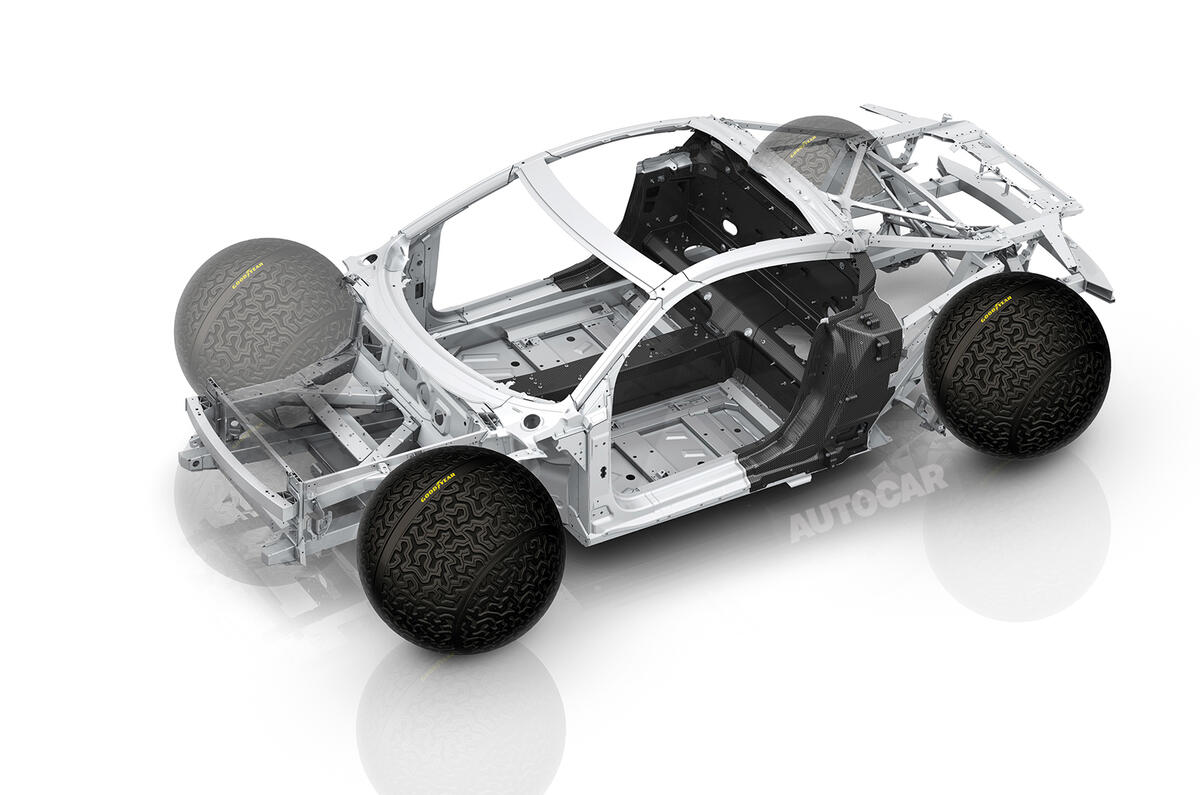Of all the clichés in a motoring writer’s repertoire, the term ‘reinventing the wheel’ has to be one of the worst. This time, however, it’s true: Goodyear’s 360 concept, a spherical wheel and tyre combination, literally reinvents the wheel. Even more radical is the fact that there is no mechanical connection between the wheels and the car at all. Instead, the body is supported over the wheels by magnetic levitation.
So is this an inspired idea, a moment of genius or maybe just plain bonkers? Far-fetched though it may sound, there’s certainly a serious element to it. Like many emerging technologies, this one was prompted by the rapid approach of autonomous vehicles.
“We envision that by 2030 most vehicles will be autonomous,” says Goodyear Dunlop’s director of consumer tyre technology, Percy Lemaire. “Capturing information will have to be done in a different way. We believe the tyre will not only connect the road to the vehicle but inform the vehicle too.”
Why a sphere? “Because the tyre can roll in any direction, providing incredible manoeuvrability and allowing a vehicle to move in any direction,” explains Lemaire. This applies not only to highway driving but to parking as well, so an autonomous vehicle could move sideways at 90deg to its centreline if necessary.
Each 360 comprises a spherical core, which forms the wheel, and an outer casing - the tyre. The core contains the powertrain, which consists of an electric motor, battery and sensors. The internal components, including the motor and battery pack, are suspended in a chassis within the wheel, with the electric motor driving the sphere via a number of small wheels. The core is stabilised by a gyro enabling it to hold station as the sphere rotates, while the battery is recharged using wireless induction charging via pads beneath the car.
The sphere can rotate through any angle, in order to even out wear or perhaps use a different area of the tread to suit different conditions. The outer casing can be removed and changed when worn, or to switch to a different type of tread – much like switching from conventional summer tyres to winters. Taking data from sensors in each wheel, computer algorithms work out what the road conditions are like, whether they are wet, dry or icy, and adapt the car’s speed and cornering rate accordingly. The car can then transmit details of those conditions to other vehicles on the road via car-to-car networking.
The tread needed to be multi-directional, so the design team opted for a method they call ‘biomimickry’, or, in other words, searching for examples in nature that might help them. In this case, they found that brain coral had the kind of structure they were looking for. “Its surface benefits from water streams coming from any direction,” explains Lemaire. “Mimicking that enabled us to design a tread that is effective in all directions.”
Another cue taken from the natural world was provided by the sponge. The base of each tread groove is formed from a sponge-like foam that softens when wet to allow more water through the groove, increasing aquaplaning resistance. The foam also absorbs water as the contact patch rolls across the surface, then flings it away through centrifugal force. In dry conditions, the sponge-like material firms up to improve grip. A further layer of foam beneath the surface of the tread allows the sphere to flatten out at its base, creating a larger contact patch with the road. Another advantage of the sphere shape is that its lower rolling resistance helps to reduce fuel consumption.
As a normal tyre rolls along the road, the bottom part flattens as it loads up with the weight of the car, so the tyre is continuously deforming – and gobbling up energy as it does so. But as the tyre springs back to shape when it leaves the road surface, some of that energy temporarily stored in the tyre is lost as heat. This process, called hysteresis, forms a large chunk of the rolling resistance. The effect is lessened with a sphere, so rolling resistance is correspondingly lower.
Magnetic levitation is already used by some trains and, according to Lemaire, consumes relatively little energy. “Although we haven’t entered into the detail of executing the concept at this stage,” says Lemaire, “our initial calculations show we would only need around 50W of electrical power per wheel to support the car. The majority of cars on the road today produce between 80bhp and 200bhp and that would be easily achievable with our system.”
So is Goodyear’s idea pure genius or just plain bonkers? Only time will tell, but if an auto engineer had been told in 1900 that cars would one day run on pneumatic tyres that give a smooth ride while being capable of travelling at more than 200mph and lasting 20,000 miles, he probably wouldn’t have believed it either.




Join the debate
Add your comment
Car Wheels
Battery life?
A few problems ?